I looked at the man in the Santa suit and figured this perpetuation-of-Santa jig of mine was at an end.  He was one of the workers at the after school care centre that my daughters attended once a week. His suit barely fit, and the fake beard, attached with eyeglasses-styled hooks over his ears was so loose that he kept pulling the white moustache over his nose to keep it from falling. It was just too easy to tell that he was not only NOT Santa, but someone we knew well. I sighed. Should I just explain he was playing at the public library event tonight because “real” Santa was booked out elsewhere? Should I try to pretend that this was Santa? Should I just give it all up?
He was one of the workers at the after school care centre that my daughters attended once a week. His suit barely fit, and the fake beard, attached with eyeglasses-styled hooks over his ears was so loose that he kept pulling the white moustache over his nose to keep it from falling. It was just too easy to tell that he was not only NOT Santa, but someone we knew well. I sighed. Should I just explain he was playing at the public library event tonight because “real” Santa was booked out elsewhere? Should I try to pretend that this was Santa? Should I just give it all up?
I thought days of Santa belief were nearly over in our house, anyway. Older children at the school playground had acted the part of Grinch by telling my daughters that Santa wasn’t real, even going so far as to say that the presents were all from ….parents. I rationalised my response by discussing the Santa Claus / Father Christmas tradition prevalent in so many cultures: “all over the world people believe in a special person who gives gifts” I said. I reminded them that daddy and I do give them gifts at Christmas, “just look under the tree right now.” I tied in Christ by reminding them that Santa wears red when he brings gifts, just as Christ would wear red at His second coming, and that Christ brings us the gift of eternal families and eternal life.
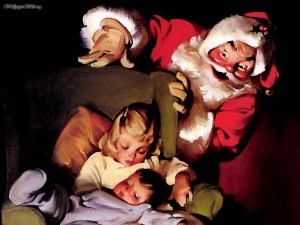 Belief in Santa is a political issue for many people I know, and probably is for me, too. As Latter-day Saints, should we teach about Santa? (Oh! How I detest the “should” word!) The discussion of the Santa Claus myth has come up at the Exponent previously, and it seems to be a popular discussion in a fair share of parenting magazines and was even a topic up for discussion at a non-LDS Facebook “Mums” group where I am a member. One woman posted against the Santa Claus myth with this opinion, “[I] have the attitude of I’m not going to lie to my kids either about Santa to have them be shocked/upset later when they find out the truth and then perhaps question what else is not real. Jesus? God? Yes it may sound extreme but how are they supposed to separate reality from make believe[?]”
Belief in Santa is a political issue for many people I know, and probably is for me, too. As Latter-day Saints, should we teach about Santa? (Oh! How I detest the “should” word!) The discussion of the Santa Claus myth has come up at the Exponent previously, and it seems to be a popular discussion in a fair share of parenting magazines and was even a topic up for discussion at a non-LDS Facebook “Mums” group where I am a member. One woman posted against the Santa Claus myth with this opinion, “[I] have the attitude of I’m not going to lie to my kids either about Santa to have them be shocked/upset later when they find out the truth and then perhaps question what else is not real. Jesus? God? Yes it may sound extreme but how are they supposed to separate reality from make believe[?]”
Is this “reality” vs. “make believe” separation an issue? Aren’t children supposed to develop a personal testimony of God and Christ, rather than depending on mine for the length of their lives? Is belief in Santa….wicked?
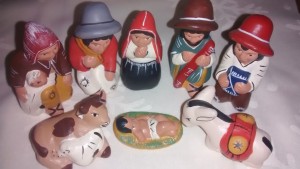 Growing up, a Santa Claus always visited my home ward’s Christmas party. I remember excitedly visiting Santa and nervously asking for the things I most wanted for Christmas. My aunt can still tearfully recall the man dressed as Santa who was visiting “from another stake,” who anonymously played the part in full jovial character as he delivered gifts and food to a very needy family in her ward. Even Bonnie Oscarson shared a story involving Santa in the 2014 First Presidency Christmas Devotional. But Santa isn’t always welcome at home or church. Last year, in a different ward and living in a country that was foreign, the ward members where we attended were angrily anti-Santa Claus. The idea was that removing Santa would better invite Christ— however, the removal of Santa also resulted in the elimination of the ward Christmas tree, the forbidding of Christmas decorations and the distinct instruction to not participate in card or gift exchanges at church. The end result was a grim and cold potluck where all were invited to display and show off their nativity-sets from home. (I refused to bring my sentimental and simple Chilean nativity set for fear it would be mocked or labeled inappropriate.)
Growing up, a Santa Claus always visited my home ward’s Christmas party. I remember excitedly visiting Santa and nervously asking for the things I most wanted for Christmas. My aunt can still tearfully recall the man dressed as Santa who was visiting “from another stake,” who anonymously played the part in full jovial character as he delivered gifts and food to a very needy family in her ward. Even Bonnie Oscarson shared a story involving Santa in the 2014 First Presidency Christmas Devotional. But Santa isn’t always welcome at home or church. Last year, in a different ward and living in a country that was foreign, the ward members where we attended were angrily anti-Santa Claus. The idea was that removing Santa would better invite Christ— however, the removal of Santa also resulted in the elimination of the ward Christmas tree, the forbidding of Christmas decorations and the distinct instruction to not participate in card or gift exchanges at church. The end result was a grim and cold potluck where all were invited to display and show off their nativity-sets from home. (I refused to bring my sentimental and simple Chilean nativity set for fear it would be mocked or labeled inappropriate.)
I don’t have a problem with believing in Christ, or God, or the Holy Ghost. I love Them! I testify of Them! My testimony of the members of the Godhead was not formed by folklore and candy canes, it was formed through study, prayer and faith. Still, before my daughters came to me—I, like many others, wondered if I would/”should” teach any children in my care about the Santa Claus myth. Adding to that was my own baggage: after a long and bitter battle of adoption, IVF and surrogacy, I swore to God that no matter what happened to me, I would not deny the Christ. After I had done all that I could, I conceded that I would not be a mother. But my testimony was not beaten. I would still attend church, even though the church cruelly taught me that I had little value outside of being a mother. My faith was shaken, but not dead. Even if God would not allow me to be a mother, I am Mormon. I vowed to never deny Christ, even in the face of Mormon culture. At that moment, Santa was the farthest thing from my mind.
The Christmas following this conceding, two smiling girls were calling me “mummy.” When they first came in the early part of the year, they had been neglected. They came hungry for food, attention and love. Their playtime routines seemed odd; they did not use their imagination much. They often modelled asking people for money while chatting on pretend cell phones, and they violently hit their dolls. We diligently worked with them and a beloved child counsellor from LDS Family Services who grew to be a close friend. Very quickly, the girls began to model rocking their dolls to sleep, holding them gently, feeding them and kissing them. The fake phones were gone, and we spoke of sharing and Christ and family. In time, the girls’ hair grew, and their bruises healed.
But they still didn’t use their imagination much. I was worried about their intellectual development, so asked our counsellor. “If you don’t know what reality is going to bring you next, it is hard to use your imagination,” she explained. “When they feel safe, they will use playtime imagination. It will come! It just takes time.” She said the last part brightly and with hope, but also firmly. Very firmly. It would take time. But they would eventually feel safe, she assured us. Then they would feel safe to use their imagination.
I decided to believe her. So I waited. And tried to model “pretend play” with them, even though they seemed to think that I was just 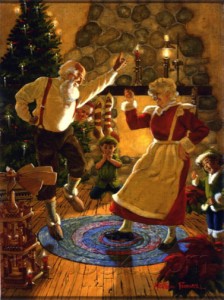 being a bit daft. Much sooner than I anticipated, and to my great relief, they were soon using their imagination and creativity every day. My eyes often welled with tears as I watched them dancing as princesses, mewing like kittens or hooting like monkeys– all things new to their activity. I cried because I knew: it wasn’t about the games, it was about them feeling safe. They were safe to dream, to hope, and to envision life as a happy thing. By the end of that first year, the teaching of Santa came naturally, as a part of the imagination we craved to create within our family. I distinctly added Ms. Claus, as the partner and co-conspirator of the Santa operation, in additional to the story of the birth of Christ. The spirit blessed us.
being a bit daft. Much sooner than I anticipated, and to my great relief, they were soon using their imagination and creativity every day. My eyes often welled with tears as I watched them dancing as princesses, mewing like kittens or hooting like monkeys– all things new to their activity. I cried because I knew: it wasn’t about the games, it was about them feeling safe. They were safe to dream, to hope, and to envision life as a happy thing. By the end of that first year, the teaching of Santa came naturally, as a part of the imagination we craved to create within our family. I distinctly added Ms. Claus, as the partner and co-conspirator of the Santa operation, in additional to the story of the birth of Christ. The spirit blessed us.
I prayed to God with heartfelt gratitude, and thanked Him for my daughters, and for their ability to use their imagination. No matter how firmly my testimony was shaken by infertility, or how neglected my daughters were before we came together, we were all safe in a joyously swirling combination of testimony and imagination. As my daughters developed, I saw how much their ability to use imagination re-enforced what I taught them about God: because they might not see Him with their eyes, but they could envision Him in their hearts. It was all intertwined for me. And for them.
Before I could imagine it, it was my 3rd Christmas as a mother, and I took my eldest to the library Christmas activity. Her younger sister was at home with my husband (AKA “daddy”), and I was enjoying the one-on-one time with her. The games were fun—the children took turns draping tinsel and ornaments over each other and declaring themselves Christmas trees, lobbing balls into cardboard holiday-shaped cut-outs for small prizes, dumping copious amounts of glitter atop globs of glue balanced on Popsicle sticks pronounced as ornaments…. And standing in line to see Santa and Ms. Claus.
 This was clearly a costumed Santa. His black, bushy eyebrows prominently laid out in front of the over-sized Santa cap, and though he was constantly adjusting the ill-fitted beard, his forehead seemed cemented in an attempt to get the beard to stay hooked to his ears. I could see his plaid lumberjack shirt through the thinly-buttoned red jacket, and his black belt looked more like a strip of a wadded up garbage bag strung together by a paperclip buckle. The white suit trim was thin and bare in some spots, being only slightly disguised by thin strips of white felt; the cotton balls I reserved at home for nail polish removal were significantly fluffier. I was sure the jig was up. She was sure to see this was not really Santa.
This was clearly a costumed Santa. His black, bushy eyebrows prominently laid out in front of the over-sized Santa cap, and though he was constantly adjusting the ill-fitted beard, his forehead seemed cemented in an attempt to get the beard to stay hooked to his ears. I could see his plaid lumberjack shirt through the thinly-buttoned red jacket, and his black belt looked more like a strip of a wadded up garbage bag strung together by a paperclip buckle. The white suit trim was thin and bare in some spots, being only slightly disguised by thin strips of white felt; the cotton balls I reserved at home for nail polish removal were significantly fluffier. I was sure the jig was up. She was sure to see this was not really Santa.
But as soon as she saw him, imagination took over. Her eyes were lost in a sparkling fantasy of hopeful joy. “Yes,” she shyly responded to his query of being on the “nice” list. As she noted some special things that she –and her sister—wanted for Christmas, I cried open tears, steaming down my face. I had not prepared to take a photo of the exchange, thinking all was lost. And now, the moment would be gone before I could fumble my phone out of my purse. So I took the moment instead of the photo. That was my Christmas moment: I savoured the spirit and witnessed the love of Christ and the magic of of His birth. In that twinkling, I was reminded—in my daughter’s ability to place aside what was really there—that God does grant the blessing of atonement. And family. And angels with bushy black eyebrows. And Christmas. And ….Santa.
So I believe in Santa. Do you?


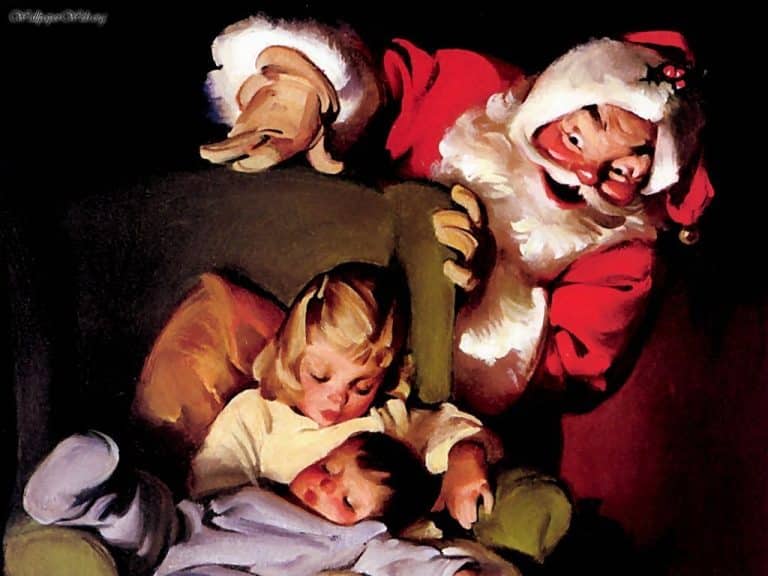
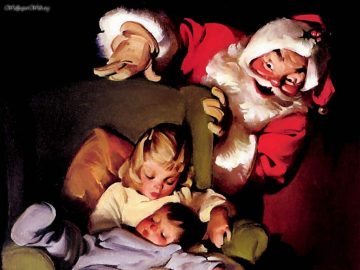


7 Responses
One of my best Christmases was a couple of years ago, when I got to volunteer at the NORAD Tracks Santa call center. The calls that touched me the most were from kids who wanted to know whether they were on the Naughty list or the Nice list. It was so much fun telling them that they were on the Nice one. One kid got too nervous though, when I asked him the correct spelling of his name and he hung up before I could answer him.
I believe in Santa and in the love and hope he represents. I hope I never stop believing in that.
I enjoy Santa and happily bought gifts “from Santa” for our kids. But I never felt the need to push their belief. I remember what my mother told me when I told her that I didn’t believe there was a Santa. She said, “Oh, that’s too bad. He brings the best gifts.” Obviously, it was a good idea to believe in Santa. At that point I realized that Santa was a really lovely game that adults enjoyed playing. If you were old enough to understand that there is no Santa, you were old enough to be part of the game and be Santa yourself(at least not telling your younger siblings that he wasn’t real!). My husband had the kids leave cookies and milk one year. That was a step too far for me. Suggesting gifts came from Santa, labeling gifts “From Santa”…no problem. But providing concrete evidence that Santa had eaten our cookies and drunk our milk? That seemed like a lie and not the benign pretend that I enjoyed. And I am creeped out by images of Santa kneeling to the baby Jesus. Fantasy and reality colliding! No!!! And I much, much prefer the 1980 British animated short “The Snowman” to “The Polar Express”.
Spunky, this is wonderful and lovely. Thank you for sharing the hope that this season is truly about 🙂
I believe in Santa, and I love to belong to a conspiracy of people bringing joy to the world.
This was really lovely. Thank you.
This was really beautiful, and resonated with me. As someone in the thick of the long and bitter battle you describe, with no end in sight, it is hard for me to picture a time when I might feel the joy and peace you also describe. Perhaps I am like your daughters, whose reality had been at times so miserable that imagining something better is a painful exercise in futility. I know infertility might pale in comparison to the very real and serious traumas others experience like abuse, hunger, terrorism, war, abandonment, etc. But it’s the worst thing that has ever happened to me and has crushed my faith into dust.
When you write “…even though the church cruelly taught me that I had little value outside of being a mother” I cry, because I know. I admire you for your remarkable faith and resilience, especially when I’m not sure I have any of it left myself. Your girls are so lucky to have found parents who truly love them and who worry about the best/ healthiest way to create a magical Christmas for them. Thank you for your example.
Yes! Yes! Yes! I believe in Santa.
This was very beautiful. I loved reading about your journey with your girls to help them bring to life their childhood wonder and imagination. I especially loved this: “I cried because I knew: it wasn’t about the games, it was about them feeling safe. They were safe to dream, to hope, and to envision life as a happy thing. By the end of that first year, the teaching of Santa came naturally, as a part of the imagination we craved to create within our family.” That’s also what I love about Santa. I love sharing in my kid’s world of imagination and creating magic for them while they are young. My kids are also getting older and having a lot of questions about Santa now. My rule is that I won’t lie to them as they bring these questions up. I ask them what they think and I help them to have the confidence to trust their own logical conclusions. Just as imaginative play is a healthy stage of childhood, cognitive dissonance is a normal part of life and I want my kids to know how to experience it in a healthy, empowering way. Thank you for your post. Sometimes I also question whether doing Santa with my kids was the “right” thing to do. It’s nice to read about a similar struggle and to hear your beautiful insights.